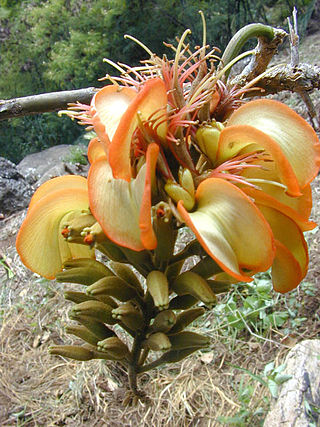
Erythrina is a genus of plants in the pea family, Fabaceae. It contains about 130 species, which are distributed in tropical and subtropical regions worldwide. They are trees, with the larger species growing up to 30 m (98 ft) in height. The generic name is derived from the Greek word ερυθρóς erythros, meaning "red", referring to the flower color of certain species.

Erythrina herbacea, commonly known as the coral bean, Cherokee bean, Mamou plant in South Louisiana, red cardinal or cardinal spear, is a flowering shrub or small tree found throughout the southeastern United States and northeastern Mexico; it has also been reported from parts of Central America and, as an introduced species, from Pakistan. Various other systematic names have been used for this plant in the past, including Erythrina arborea, Erythrina hederifolia, Erythrina humilis, Erythrina rubicunda, Corallodendron herbaceum and Xyphanthus hederifolius.

Wiliwili is a species of tree in the pea family, Fabaceae, that is endemic to the Hawaiian Islands. It is the only species of Erythrina that naturally occurs there. It is typically found in Hawaiian tropical dry forests on leeward island slopes up to an elevation of 600 m (2,000 ft).

Erythrina crista-galli, also known as the cockspur coral tree or ceibo, is a species of flowering tree in the family Fabaceae, native to Argentina, Uruguay, southern Brazil and Paraguay. It is widely planted as a street or garden tree in other countries, notably in California. Its specific epithet crista-galli means "cock's comb" in Latin.

Erythrina mulungu (Mulungu) is a Brazilian ornamental tree and medicinal plant native to the cerrado and caatinga ecoregions in Brazil, South America.

Erythrina variegata, commonly known as tiger's claw or Indian coral tree, is a species of Erythrina native to the tropical and subtropical regions of eastern Africa, the Indian subcontinent, northern Australia, and the islands of the Indian Ocean and the western Pacific Ocean east to Fiji.

Erythrina vespertilio is a tree native to north and north-east Australia. Its common names are grey corkwood, bat's wing coral tree, yulbah and the more ambiguous "bean tree". In the Western Desert language it is known as ininti and the in Arrernte and Anmatyerr it is known as atywerety.

Erythrina falcata, commonly known as the Brazilian coral tree, is a timber tree in the family Fabaceae native to tropical South America. It can be found in Argentina, Bolivia the Atlantic Forest vegetation in Brazil, Paraguay and Peru. This plant is also used as a medicinal plant and ornamental plant which is attractive to birds.

Erythrina humeana, commonly known as the dwarf coral tree, dwarf erythrina or Natal coral tree, is an ornamental tree native to South Africa.

Erythrina fusca is a species of flowering tree in the legume family, Fabaceae. It is known by many common names, including purple coraltree, gallito, bois immortelle, bucayo, and the more ambiguous "bucare" and "coral bean". E. fusca has the widest distribution of any Erythrina species; it is the only one found in both the New and Old World. It grows on coasts and along rivers in tropical Asia, Oceania, the Mascarene Islands, Madagascar, Africa, and the Neotropics.
Erythrina schliebenii is a species of legume in the family Fabaceae. It is found only in Tanzania. The species is named for German collector and botanist Hans-Joachim Schlieben.

Utricularia resupinata, popularly known as lavender bladderwort or northeastern bladderwort, is a small perennial subaquatic carnivorous plant that belongs to the genus Utricularia. It is native to eastern Canada, the United States, and Central America. This plant species has an interesting etymology, growth pattern, ecology, and research history. As a plant that is threatened or endangered in many of the States where it is found, it is a candidate for sound conservation efforts.
This is a list of plants which includes trees and other herbs, vines, climbers, lianas, shrubs, subshrubs that are native or endemic, found in Cuba.

Erythravine is a tetrahydroisoquinoline alkaloid found in the plant Erythrina mulungu and other species of the genus Erythrina.

Erythrina × bidwillii is the scientific name for two different cultivars produced from hybridising Erythrina species at Camden Park Estate, New South Wales, Australia, in the early 1840s by William Macarthur, one of the most active and influential horticulturists in Australia.
A geoxyle is a plant in which an enlarged, woody structure occurs beneath the surface of the ground. Such plants have developed independently in various plant lineages, mostly evolving in the Pliocene and subsequently diverging within the last two million years. In contrast to their close relatives, these plants have developed in areas with both high rainfall and a high frequency of fires. They are sometimes known as underground trees, and the areas where they grow as underground forests.

Erythrina senegalensis, the Senegal coraltree, is a plant in the pea family Fabaceae, native to West Africa.
Stelis resupinata is a species of orchid plant native to Mexico.

Erythrina suberosa, the corky coral tree, is a species of flowering plant in the family Fabaceae. It is native to the Indian Subcontinent, Southeast Asia, and Peninsular Malaysia. Due to its showy flowers and habit of flowering most of the year, it is often planted as an ornamental or street tree. Although the flowers can be used to make a refreshing drink, the seeds are poisonous.

Erythrina corallodendron, the red bean tree, is a species of flowering plant in the family Fabaceae. It is native to the Caribbean; Jamaica, Hispaniola, Puerto Rico, the Leeward Islands, and the Windward Islands, and has been introduced to Trinidad and Tobago, Kenya, Réunion, and the Malay Peninsula. A small tree usually 3 m (10 ft) tall, but rarely reaching 10 m (33 ft), and with showy flowers, it is often planted as an ornamental.
















